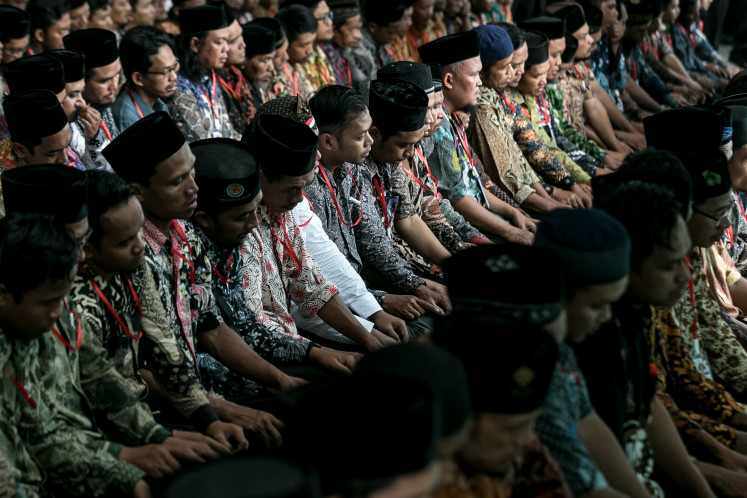Popular Reads
Top Results
Can't find what you're looking for?
View all search resultsPopular Reads
Top Results
Can't find what you're looking for?
View all search resultsIn vernacular music we trust
The case of folk music on our indie-scene is the perfect example to speak about the significance of vernacular music in our culture. How vernacular idioms have shaped our modern music.
Change text size
Gift Premium Articles
to Anyone
I
t is a well-known pattern in the cultural-studies field: the dichotomy between established and vernacular culture. Although the former is always remarkably known when we mention culture, the latter somehow has its own importance to the continuity of culture.
Specifically in music, the pattern always has similarity to our historical timeline. For instance, for the last five years, folk music has been positioned as the new “everyone’s favorite” on the Indonesian indie scene. If you form a duo with one guitar or a ukulele player, one singer who sings a typical lyric about pulang (coming home) or hujan (rain), intertwine a minimalistic arrangement with one or two bars of glockenspiel, you’re going to be considered a folk musician.
So, folk has arisen as the new established culture then. But if we take a look back in time, folk music is vernacular. Gypsy music was a pain in the ears for the European aristocratic royals. As time went by and the music trended, it changed path all the time, folk music moved from the vernacular into established culture. In particular, we could mention 1970s folk troubadours such a Bob Dylan, Woodie Guthrie, or the Indonesian version of both: Iwan Fals.
The case of folk music on our indie-scene is the perfect example to speak about the significance of vernacular music in our culture. How vernacular idioms have shaped our modern music.
In his book Noise Uprising, Michael Denning defines vernacular music as a music that emerged and was played outside the aristocratic tradition. On its breakthrough, the aristocrats labeled vernacular as noise, the unwanted frequency. The vernacular music being disseminated was heard as noise by the established and cultivated elites: it was unrespectable and disrespected. Moreover, Denning argues that the vernacular music revolution emerged from the soundscape of working-class daily life in an archipelago of colonial ports.
Like Denning, in his book The Rest is Noise, Alex Ross said that everything outside the established status-quo of music could be considered as a noise, or vernacular. Thus, Ross mentioned how jazz, in its dialectic of establishment circa the 1920s was labeled as noise by established music patrons, even by famous Frankfurt school thinker Theodor Adorno, whose essays of the 1920s and 1930s denounced jazz as “world-economic resonance in cheap foreign locales that could be imported at will”.
Maybe Adorno never thought that jazz would later move from the soundscape of the workingclass pub into those fancy highclass cafes. Jazz is not vernacular anymore; it is now the signifier of high-art music grandiose.
Henceforth, we can see the signification of vernacular music is crystal clear. The list would be long if we tried to write it down. The 1990s had their renowned Seattle sound movement. Beforehand, the Seattle sound was an underdog in the American music scene. Suddenly it all changed when Nirvana boomed, the media give it the name “grunge”, voila, vernacular music conquered established music.
In traditional Indonesian music terms, Javanese gamelan could be considered one of the most notably known ethnic ensembles. The long history of Javanization by the New Order put gamelan in the privileged position of “national high-art culture”. It is a product of established aristocratic society, invented and played inside the high walls of the Javanese sultan’s palace.
Lay people could not play the gamelan simply because they could not afford to buy the expensive bronze instruments. Thus, they lacked access to this musical genre.
As a result, the people who lived near Yogyakarta palace invented their own type of gamelan, using a cheaper and affordable material that grew everywhere across the archipelago: bamboo. This was genius. People from Banyumas, and other southern areas of Java, invented their calung or angklung, so they had their own kind of Karawitan. Of course, it was labeled as lowart by the established aristocratic gamelan artists.
Nowadays, we can hear this vernacular bamboo instrument all across the city of Yogyakarta. On the corner, by the traffic lights, calung are played by street buskers. At the mall, the fancy symbol of modern life, sometimes we can hear familiar bamboo tunes.
Even at government functions, sometimes calung ensembles play. The vernacular bamboo music from the past now surrounds Yogyakarta, the center of established aristocratic music.
Meanwhile, in the pop music industry, we hardly recognize dangdut — a mixture of Malay, Indian and rock — labeled as noise or called “dog s**t music” by famous rock singer Benny Soebardja in the 1970s. Since then, however, dangdut has been labeled vernacular music.
The funny thing is, as sociologist Ariel Heryanto writes in his pop culture study on how female dangdut singer Inul Daratista emerged in the 2000s, once again we can learn from the significance of vernacular music.
At that time, dangdut changed the trend of the Indonesian music industry. Rhoma Irama forced Ahmad Albar, a famous rocker, to write the dangdut-style “Zakia”, Inul could make pop group Project Pop arrange a Linkin Parkstyle song titled “Dangdut is The Music of My Country”.
Time will tell, the significance of vernacular music must be a blatant vision to our eyes now. Without doubt, vernacular music has shaped modern music. It reinvented the genres, trends and tunes we hear.
On the other hand, speaking about industry and capitalistic motives, while recognizing the significance of vernacular music, the established status quo (artists, record labels, media) will easily dismiss the belittled vernacular as noise — disrespectful and annoying harmony. They will reinvent vernacular music so they can sell it.
A good example of this phenomenon is the viral “om telolet om”, the vernacular phrase originated from kids who yelled to bus drivers to sound their unique telolet horn. When this phrase and three-to-five second melody became viral, a Western DJ remixed it into a song.
The lesson from vernacular music: snobbery is nonsense then. Sometimes when we hear music dubbed as high art, we easily judge vernacular music as low art, shallow or noisy. It is a shame because history has proven that vernacular music plays as pivotal role as that of established music.
Until it is proven otherwise, our pretentious judgment of vernacular music is nonsense and snobbish. And it will not bring us anywhere other than shallow debate.
Now, in vernacular music we can trust. As Béla Bartók wrote in his 1933 reflections: “The urban [established] music frequently sounds stilted, affected and artificial; the peasant [vernacular] music, on the other hand, gives the impression of being a far more spontaneous and vivid manifestation”.
Your Opinion Matters
Share your experiences, suggestions, and any issues you've encountered on The Jakarta Post. We're here to listen.
Thank you
Thank you for sharing your thoughts. We appreciate your feedback.










